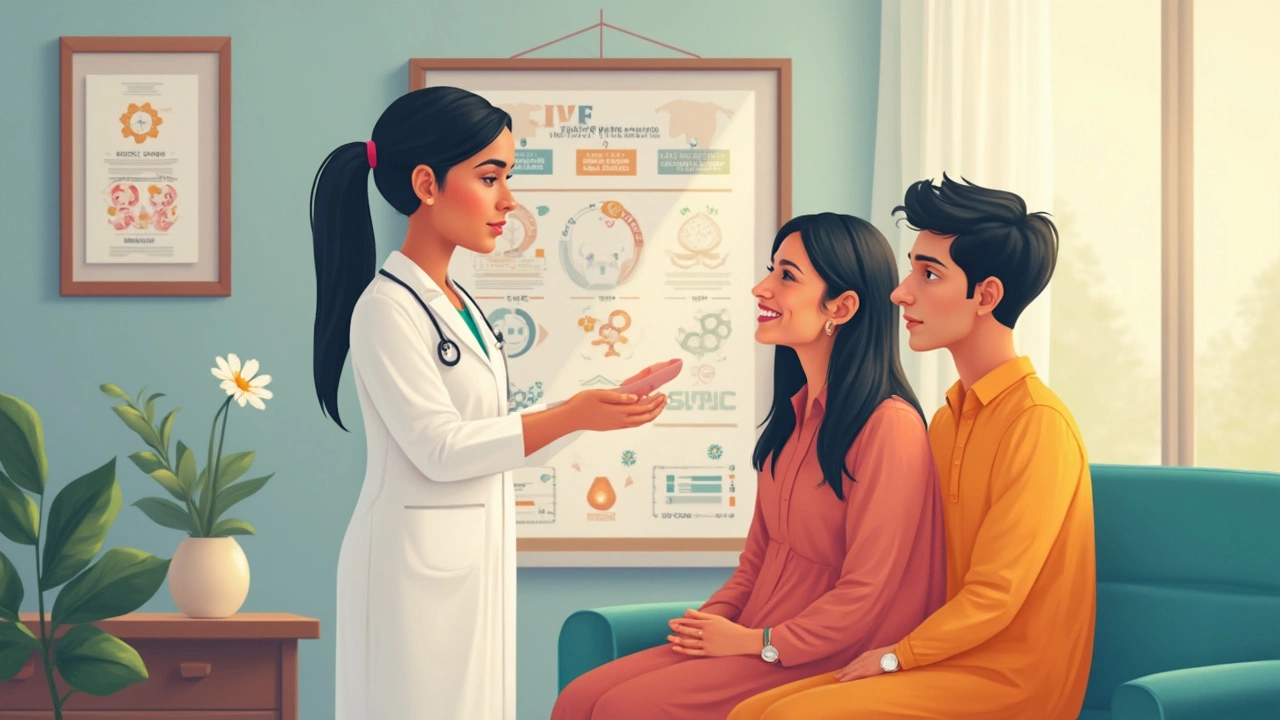Most people have no idea the stuff even famous couples go through to start a family. Michelle Obama actually talked about using IVF to have both Malia and Sasha—a detail she opened up about in her memoir, "Becoming." Before that, people just assumed everything happened naturally for them. Turns out, Michelle had a miscarriage first and then struggled with fertility until her doctor brought up IVF as an option.
If you’re dealing with similar struggles, knowing this kind of thing about famous families can be a relief. IVF (in vitro fertilization) isn’t exactly a simple process, but it’s way more common than folks think. For Michelle and Barack, it worked—but it took openness, patience, and a willingness to ask for medical help when they needed it.
Thinking about IVF yourself? Hearing about the Obamas normalizes the ups and downs of trying to have kids. There’s no shame in seeking fertility treatment. If you want to know what IVF really involves, what it costs, and how to prep, you’re in the right spot.
- The Obamas’ Personal IVF Story
- What Is IVF and How Does It Work?
- Why More Couples Are Choosing IVF
- The Costs, Challenges, and Realities
- Practical Tips If You’re Considering IVF
The Obamas’ Personal IVF Story
This might surprise you: Michelle Obama went public about her fertility struggles only after leaving the White House. In her memoir, she shared how, in her mid-30s, she was shocked by a miscarriage and realized quickly that making a family isn’t always simple. She described it as feeling lost and alone—like she’d failed. But Michelle soon noticed that a lot of women go through the same thing and just don’t talk about it.
She and Barack Obama turned to IVF (in vitro fertilization) after failed attempts to conceive naturally. Michelle says she gave herself hormone shots at home, sometimes with Barack helping, all while juggling her busy schedule as a lawyer. This open conversation busted a lot of the secrecy around infertility, especially in the Black community, where it’s often hush-hush.
For the Obamas, IVF worked. Both their daughters, Malia and Sasha, were born thanks to this treatment. Michelle’s honesty helped break a stigma and led to more open discussions about fertility, miscarriages, and the realities of family-building. She talks about how she didn’t realize how common all this was until she actually opened up and listened to other women.
Michelle wrote, “I felt like I had failed because I didn’t know how common miscarriages were—because we don’t talk about them.” Since then, she’s been a strong voice for making infertility less of a secret and more of a shared experience. If you’re in this boat, seeing a high-profile couple like the Obamas go through IVF shows it’s nothing to be embarrassed about.
| Fact | Detail |
|---|---|
| Age at time of IVF | Mid-30s (Michelle) |
| No. of daughters via IVF | 2 (Malia & Sasha) |
| Public disclosure | Michelle’s memoir, interviews (2018) |
What Is IVF and How Does It Work?
IVF stands for in vitro fertilization. It’s a process where doctors help people have a baby by joining an egg and sperm outside the body—usually in a lab dish. Once the embryo forms, it’s put into the woman’s uterus to hopefully start a pregnancy. IVF has been helping families since 1978, and it’s now one of the most common fertility treatments out there.
Here’s how the basic IVF process usually looks:
- Ovarian stimulation: The person with eggs takes hormone shots to make their ovaries produce several eggs instead of just one.
- Egg retrieval: When the eggs are ready, the doctor removes them in a quick procedure—usually under light sedation.
- Fertilization: The eggs get mixed with sperm in a lab dish. Sometimes doctors directly inject the sperm into the egg.
- Embryo culture: The fertilized eggs grow in the lab for a few days—specialists watch to see which embryos are developing well.
- Embryo transfer: A healthy embryo (sometimes more than one) is placed in the uterus with a tiny tube.
The whole thing takes about two to six weeks, start to finish. Some folks might need more than one round. It’s pretty common for people to need a couple tries before it sticks—nothing unusual about that.
If you’re curious about success rates, a lot depends on age, medical conditions, and how the embryos look. On average, women under 35 have a better chance each cycle, but lots of older people have success too. Here’s a quick look:
| Age Group | Average Live Birth Rate Per IVF Cycle |
|---|---|
| Under 35 | About 40% |
| 35-37 | About 31% |
| 38-40 | About 21% |
| 41-42 | About 11% |
Just remember, these are averages. Everyone’s situation is a little different, so numbers can swing either way. Still, these stats help set expectations about IVF and give a real-world look at why so many couples—including the Obamas—give it a try.

Why More Couples Are Choosing IVF
There’s no denying it: IVF rates are rising. Just in the U.S., about 2% of all babies are now born through IVF or similar assistive reproductive tech, according to the CDC. The reasons couples turn to IVF are changing too—it's not just for those struggling with obvious infertility.
What’s pushing this trend? For starters, people are waiting longer to have kids. Careers, finances, and personal goals mean a lot of women don't try for a family until their 30s or later, where rates of natural fertility drop. IVF gives hope when nature’s timeline isn’t cooperating.
There’s also a lot more awareness now. Stories like the Obamas' have made it way less taboo to talk about infertility. Couples realize they're not alone when things don't happen right away, and they’re faster to look for medical options. Plus, the tech keeps getting better. Success rates are way higher now than 20 years ago, and doctors can spot issues that used to go undiagnosed.
Same-sex couples, single parents, and people with genetic concerns are part of the picture too. IVF offers a path to a biological child where other routes weren’t possible before. Here’s what’s really moving the needle:
- Later parenthood: More people want to start families in their 30s or even 40s.
- Better success rates: Clinics now reach live birth rates over 40% for women under 35 per cycle, based on CDC data.
- Fewer stigmas: Hearing public figures like Michelle Obama talk about IVF helps couples feel less alone.
- More accessibility: Insurance coverage is slowly improving—some states even mandate benefits, taking the sting out of those bills.
Check out how the numbers have changed:
| Year | Babies Born via IVF in US |
|---|---|
| 1996 | ~20,000 |
| 2010 | ~60,000 |
| 2023 | ~97,000 |
The takeaway? More people are open about turning to IVF, and it’s become a real solution for a growing list of family types. It’s not just for the rich or famous anymore—if you’re curious, you’re definitely not the only one.
The Costs, Challenges, and Realities
Let's get real—IVF isn't cheap. In the US, a single cycle can cost anywhere from $12,000 to $15,000, and that's before you add in medications, which can run another $5,000 or more. Insurance rarely covers the whole deal, so couples end up dipping into savings or taking on debt. For the Obamas, affording it was possible, but for most people, the price is a huge hurdle.
| Average IVF Cycle Cost (USD) | Medications | Success Rate (under 35) |
|---|---|---|
| $12,000 - $15,000 | $5,000+ | ~40% |
Money isn't the only challenge. The process itself is physically and emotionally intense. Daily hormone shots leave folks moody, bloated, and tired. You'll be visiting the clinic a lot—sometimes every other day for blood tests or ultrasounds. There’s also no guarantee of success. Even with top fertility doctors, the average chance of having a baby per IVF cycle for women under 35 is about 40%. For women over 40, it drops below 10%.
Beyond physical stress, IVF puts relationships through the wringer. The Obamas have mentioned how isolating the experience felt, even with strong support around them. There is the pressure to stay positive, keep working, and handle daily life, all while trying to stay hopeful. Couples end up having a lot of tough conversations about money, what-ifs, and next steps if IVF doesn't work right away.
What helps? Knowing the facts, having a backup plan, and getting support—whether it's a therapist, close friends, or others who have done IVF. No one should go through this alone. If you’re considering this road, ask clinics about payment plans and success rates, and see if your state has any IVF insurance mandates.

Practical Tips If You’re Considering IVF
If you think IVF (in vitro fertilization) could be right for you, you’ll want to be realistic, prepared, and know what options you’ve got. Here’s a run-down to keep things straightforward and manageable.
- Get a thorough fertility assessment first. Don’t just jump in. Both partners should get basic fertility tests—think hormone checks, semen analysis, and maybe an ultrasound—so you know what you’re working with. No sense stressing about IVF if something simple might work first.
- Research clinics, not just doctors. Every clinic has different success rates, protocols, and costs. It’s worth checking out CDC-reported success rates for clinics in your area. Pro tip: Higher price doesn’t always mean higher success.
- Plan for costs upfront. IVF isn’t cheap, and most insurance doesn’t cover it. On average, one cycle runs between $12,000 and $15,000 in the U.S., not counting meds, which can tack on $3,000 to $5,000. Double-check what your insurance might pitch in for, if anything.
- Know your odds. IVF worked for Michelle Obama, but everybody’s numbers are different. Data from the CDC shows that women under 35 have around a 40% chance of a live birth per cycle, but those odds drop with age.
- Prep for the mental side. IVF is stressful. Couples can feel hopeful one minute and crushed the next. Think about lining up support—maybe a counselor or a group for people going through fertility stuff. You’re not alone, and talking to others helps a lot.
- Don’t ignore diet and lifestyle. Eating well, getting enough sleep, and ditching smoking or heavy drinking bump your odds up. You don’t have to go overboard, but the basics matter.
| Age | Average Live Birth Rate per IVF Cycle |
|---|---|
| Under 35 | 40% |
| 35-37 | 31% |
| 38-40 | 21% |
| 41-42 | 11% |
| Over 42 | 4% |
One last tip: Don’t feel pressured to tell everyone what you’re doing. This is your journey, and you decide who gets to know. Whether you end up making your story public, like the Obamas, or keep it between close friends, it’s your call.
